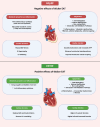Refining the link between obesity and heart failure: insights from GLP-1 receptor agonist trials and studies adopting direct adiposity measures
- PMID: 40405237
- PMCID: PMC12096527
- DOI: 10.1186/s12933-025-02778-6
Refining the link between obesity and heart failure: insights from GLP-1 receptor agonist trials and studies adopting direct adiposity measures
Abstract
Overweight and obesity are major risk factors for heart failure (HF), contributing to its development through metabolic, neurohormonal, haemodynamic, and inflammatory alterations. While overweight/obesity increases the risk of developing HF, its impact on patient outcomes remains complex. The "obesity paradox" suggests that a higher BMI may be associated with improved survival in patients with established HF. However, recent GLP-1 receptor agonist (GLP-1 RA) trials suggest that intentional weight loss positively influences outcomes in overweight/obese patients with HF. This seemingly contradictory evidence highlights the need for a deeper understanding of the mechanisms linking adiposity to HF outcomes. A more precise characterization of adiposity phenotypes using alternative and accurate measures of pathological fat accumulation is crucial in identifying individuals who may benefit most from anti-obesity treatments. In this context, recent research underscores the role of epicardial adipose tissue (EAT) in HF pathophysiology, as it directly influences cardiac function and structure through inflammatory, metabolic, and mechanical effects. This narrative review summarises current evidence on the impact of weight loss on HF outcomes, focusing on recent GLP-1 RA trial results. Additionally, it highlights epidemiological and molecular data supporting EAT as a novel adiposity measure that might allow refining patient selection for pharmacological weight-loss treatments. Finally, it emphasizes the need for future research to identify causal pathways linking alternative measures of visceral fat accumulation to HF outcomes. These efforts will be essential in optimizing the benefits of novel weight-loss treatments, ensuring effective and individualized therapeutic strategies for overweight or obese patients with HF.
Keywords: Epicardial adipose tissue; Epigenetic; GLP-1 RA; Heart failure; Obesity.
© 2025. The Author(s).
Conflict of interest statement
Declarations. Competing interests: DT reports receiving fees for serving on advisory boards from Amarin, Boehringer Ingelheim and Novo Nordisk, lecture fees from Eli Lilly, and travel support from AstraZeneca. FP reports receiving fees for serving on advisory boards from Novo Nordisk. He also serves as Guest Editor for the thematic collection to which the current manuscript has been submitted; as such, has not been involved in the peer review process for this article.
Figures


References
-
- Aune D, Sen A, Norat T, Janszky I, Romundstad P, Tonstad S, Vatten LJ. Body mass index, abdominal fatness, and heart failure incidence and mortality: a systematic review and dose-response meta-analysis of prospective studies. Circulation. 2016;133(7):639–49. - PubMed
-
- Kenchaiah S, Evans JC, Levy D, Wilson PW, Benjamin EJ, Larson MG, Kannel WB, Vasan RS. Obesity and the risk of heart failure. N Engl J Med. 2002;347(5):305–13. - PubMed
Publication types
MeSH terms
Substances
Grants and funding
- 310030_197557/Swiss National Science Foundation to Francesco Paneni
- FF19045/Swiss Heart Foundation to Francesco Paneni
- PE_00000019 "HEAL ITALIA" to Stefano Taddei, CUP I53C22001440006/European Union-NextGenerationEU through the Italian Ministry of University and Research under PNRR-M4C2-I1.3
- PE_00000019 "HEAL ITALIA" to Stefano Taddei, CUP I53C22001440006/European Union-NextGenerationEU through the Italian Ministry of University and Research under PNRR-M4C2-I1.3
- PE_00000019 "HEAL ITALIA" to Stefano Taddei, CUP I53C22001440006/European Union-NextGenerationEU through the Italian Ministry of University and Research under PNRR-M4C2-I1.3
LinkOut - more resources
Full Text Sources
Medical
Research Materials
Miscellaneous

